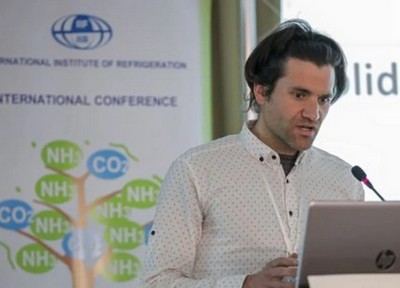Sorption process points to small-scale applications of ammonia refrigeration
May 29, 2023

The use of the sorption process in ammonia (R717)-based refrigeration represents a scalable solution that broadens the horizon for small-scale applications of ammonia.
That was the message from Aleix Pubill, a scientist working for SOFRIGAM Group, who presented a research paper on “Sold sorption of ammonia observed at the salt grain scale and its refrigeration and thermal powers” at the 10th International Institute of Refrigeration (IIR) conference held in Ohrid, North Macedonia, April 27–29.
Sofrigram Group is the parent company of Coldway Technologies, a French manufacturer of solid-gas sorption refrigeration units used in transportation.
In the sorption process, one substance will heat or refrigerate depending on whether it is absorbed or released by another substance.
“As we delve deeper into understanding the sorption process, we are edging closer to a new era in refrigeration technology, one that promises higher efficiency and greater adaptability,” says Pubill.
Ammonia-based systems have been long celebrated for their high energy efficiency and environmental sustainability. However, the scarcity of small-scale, low-power solutions has often limited their wider use in certain applications. Yet, new advancements in solid-gas sorption systems, using a reversible chemical reaction, could change this landscape.
“Because of this heating and cooling effect and increasing awareness of energy consumption and environmental footprint, these findings indicate the future of refrigeration could be significantly more sustainable and flexible than previously thought,” Pubill said.
Simultaneous refrigeration and heat production
Pubill’s paper described a thermochemical ammonia-based sorption system that alternates between a power-consuming and power-producing phase, offering simultaneous refrigeration and heat production.
“During the ammonia absorption phase, at the evaporator and reactor side, the system demonstrates impressive power capabilities,” Pubill stated. “Particularly with calcium chloride [CaCl2], heat and refrigeration capacities are at 255W/g [2TR/oz] and 85W/g [0.6TR/oz] respectively.”
This demonstrates “the high potential of these systems in providing versatile and powerful refrigeration solutions,” he said.
The sorption process capitalizes on a reactive salt, enabling the system to deliver “tunable heat” and refrigeration power, without complex small compressors, especially adopted for ammonia. The chemical sorption process of ammonia at the salt grain level is central to this approach.
Pubill used a state-of-the-art Keyence VHX 7000 microscope to observe the growth process of salt grains during ammonia intake. Post-processing of the 2D images and 3D composition of the grain enabled an estimation of volume increase during the process.
The grains were observed to swell to almost four times their original volume, providing compelling evidence of the effective absorption of ammonia by the salt. Concurrent measurements of the decay in ammonia gas pressure permitted an evaluation of the absorption rate.


